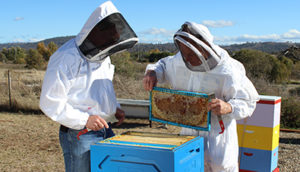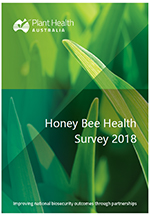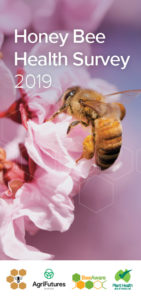Read the latest information on
Foot-and-mouth disease
 The Honey Bee Health Survey of 2018 was designed to provide a snapshot of bee health in the Australian honey bee industry.
The Honey Bee Health Survey of 2018 was designed to provide a snapshot of bee health in the Australian honey bee industry.
Dr Kath DeBoer, coordinator of the National Bee Biosecurity Program at Plant Health Australia, said that the survey asked participants about their knowledge of pest and disease symptoms, and the Australian Honey Bee Industry Biosecurity Code of Practice.
“The response to the survey was really positive. We appreciate the time people put into doing the survey,” said Kath.
“Of the nearly 4000 participants – about 15 percent of registered beekeepers – 94 percent were hobby beekeepers (with less than 50 hives), so we can get a lot of valuable information about trends across the country.”
It’s important for the Australian honey bee industry to have hobby beekeepers involved in biosecurity activities because they far outnumber the commercial beekeepers. They may be the first to find and report a new or unusual pest in their hives and willingly offer hands-on help when there are pest incursions to deal with.
“The results obtained from this survey will help to decide where education and awareness activities by industry and government are needed most,” said Kath.
 One thing that came from the results is that of the 40 percent of hobby beekeepers who reported losing hives, most were lost due to pests and diseases, followed by overwintering and queen loss.
One thing that came from the results is that of the 40 percent of hobby beekeepers who reported losing hives, most were lost due to pests and diseases, followed by overwintering and queen loss.
“Implementing biosecurity practices and completing pest and disease training will help beekeepers learn how to prevent and manage pests and diseases, and prevent hive loss,” said Kath.
“While 95 per cent of beekeepers inspect their hives for established pests and diseases such as American foulbrood, fewer people are inspecting their hives for exotic pests such as varroa.”
The good news is that many beekeepers are taking steps to increase their knowledge of pests and diseases, with 4 out of 10 beekeepers doing some form of pest and disease training in the last three years.
“I’d encourage any beekeepers who haven’t yet done any training to do so.”
Kath said it was pleasing to see that most beekeepers know who to contact if a notifiable pest or disease was in their hives.
“They said they would contact their state or territory government department an apiary or bee biosecurity officer or the Exotic Plant Pest Hotline.”
“Bee biosecurity officers are available in six states to help identify pests and diseases and to provide advice on how to manage them,” said Kath.
The 2018 Honey Bee Health Survey also indicated that over half of commercial beekeepers provided pollination services for crops like almonds, macadamias, avocados, apples and cherries often travelling long distances to provide these services.
The full report on the Australian Honey Bee Health Survey 2018 is available from the BeeAware website. Some video animations are also available that give a snapshot of the survey results.
Visit beeaware.org.au for more information about biosecurity measures to protect bees, the Biosecurity for Beekeepers training course, the Australian Honey Bee Industry Biosecurity Code of Practice, and the contact details for a biosecurity officer.
 The 2019 Honey Bee Health Survey is well underway, and the results will be compared with those of the 2018 survey to track the health of Australia’s population of honey bees.
The 2019 Honey Bee Health Survey is well underway, and the results will be compared with those of the 2018 survey to track the health of Australia’s population of honey bees.
If you’d like to participate in the survey or know someone who would, please go to bit.ly/BeeHealthSurvey2019 to complete the survey, which closes 31 December 2019.
Acknowledgement: the 2018 survey was supported by funding from AgriFutures Australia as part of the AgriFutures™ Honey Bee and Pollination Program as part of the project (PRJ-010226): ‘Improving Biosecurity Resources and Better Understanding Bee Health in Australia’ and delivered by Plant Health Australia